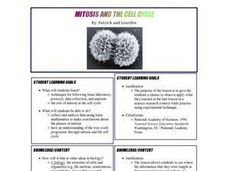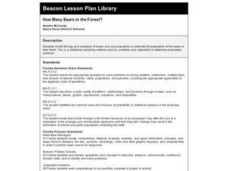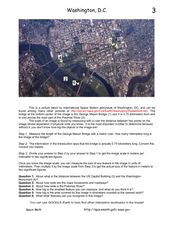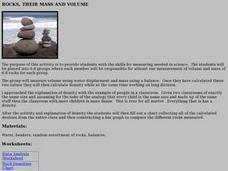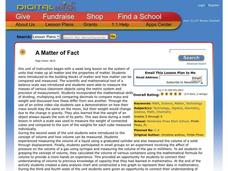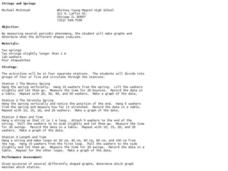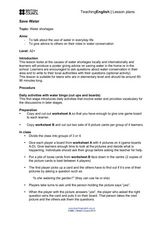Curated OER
Math in Science-Sound Reasoning
In this basic math skills worksheet, students use division, decimals and multiplication to calculate the speed of sound in water and compare it to the speed in air. They calculate distances sound travels in water and the time it takes...
NOAA
A Matter of Density
Larvae transportation on the New England seamounts is based on the density of the water. Scholars calculate density and graph salinity versus temperature to better understand the distribution of organisms in a water column....
Curated OER
Sedimentation in the Grand Canyon
In this sedimentation worksheet, learners use the current rate of sediment deposit by the Colorado River in the Grand Canyon to answer questions about the changes taking place in the canyon. They graph the amount of deposit over 75 years...
Curated OER
Distances in Space
In this distances in space worksheet, students learn about astronomical units and light years as measurements for great distances. Students use both of these units of measurements to solve five problems.
Space Awareness
History of the Universe
Your pupils may believe that you and their parents are the oldest things in the universe, but surprise! There are elements of the universe that are even older. Elementary scientists create a class timeline to demonstrate the...
Curated OER
Small Angle Calculations
Students work with circles, angles and estimating angles in the night sky. In this circles and angles lesson, students practice measuring a degree using the circumference of a circle and apply the degree to determine a way to use their...
Curated OER
Mitosis And the Cell Cycle
Students determine the approximate time a cell spends in each phase of mitosis by counting cells in each phase from a prepared slide. They use a few simple calculations to estimate how long cells spend in each cycle in the body.
Curated OER
Revolutions in the Solar System
Third graders conduct research on the solar system. In this solar system lesson, 3rd graders will work in groups of four to create a power point presentation from their findings. They divide the research amongst the members in their...
Curated OER
How Many Bears in the Forest?
Third graders model the tag and recapture of bears and use proportions to estimate the population of the bears in their forest. This is a statistical sampling method used by scientists and naturalists to determine population numbers.
Curated OER
LRO Explores Lunar Surface Cratering
In this lunar surface worksheet, students use an image taken by the LRO satellite to investigate the size of craters on the moon's surface, to determine the crater density and to find the average distance between the craters.
Curated OER
Inferring Height From Bone Length
Learners determine the relationship between bone length and height. In groups, they are told the race and gender of the individual and discuss how this affects height. They measure the lengths of the bones in metric measurements and...
Curated OER
Craters on the Moon
In this moon craters worksheet, students use a high resolution image of the lunar surface and calculate the image scale in meters per millimeter. They use the image scale to find the largest crater in the image, the smallest crater, the...
Curated OER
Exploring a City from Space
In this exploring cities from space worksheet, students use a satellite image from the QuickBird Satellite to determine the image scale. They use the image scale to calculate the length of the Bellagio Hotel in Las Vegas, the length of a...
Curated OER
Washington D.C. from Space
In this Washington D.C. from space worksheet, students use a picture generated by the International Space Station and they find the scale of the image. They determine the actual size of features in the image, they find the distances...
Curated OER
How Big is a Lunar Crater?
For this lunar crater worksheet, learners use an image taken by the Lunar Orbiter spacecraft to find the scale of the image and determine the diameter of the lunar crater Tycho. They also find the size of the smallest and largest...
Curated OER
Asteroid Eros
In this asteroid image worksheet, students observe a photograph taken by the NEAR imager and they determine the scale of the image following the given steps. They solve 4 problems using the scaled image and determine the dimensions, the...
Curated OER
Let's Measure
Students learn how to measure length using inch units. In this measurement lesson, students use two different units of measure to measure the length of a Leopard Shark and then use pattern blocks to measure its length. ...
Curated OER
Six of One, Half Dozen of the Other
Students explore the garden with all five senses. In this Science lesson plan, students collect specimens from the garden to classify. Students use adjectives to describe the objects collected.
Curated OER
Avalanche on Mars!
In this mars and scaling worksheet, students use the given image to determine the dimensions of the image and the size of specific details on the image. They calculate the image scale in meters in order to determine specific...
Curated OER
Rocks, Their Mass and Volume
Students measure volume using water displacement and mass using a balance. Once they have calculated these two values they will then calculate density while at the same time working on long division. After the activity and explanation of...
Curated OER
A Matter of Fact
Students design their own Science experiment. For this science experiment lesson students create a hypothesis related to matter and test it. They displayed their data in a graph.
Curated OER
Strings and Springs
Ninth graders explore physics with springs and strings. In this force and motion lesson, 9th graders rotate through four stations exploring how various springs stretch and bounce, and how mass and length affect a pendulum's swing. They...
Curated OER
Water Shortages
Students explore natural elements by participating in a bingo activity. In this water usage instructional activity, students discuss the importance of clean water and complete worksheets based on water shortage statistics. Students...
Curated OER
Making Data Meaningful
In this sample mean activity, students explore different ways "average" is used. Students use this information to find the sample mean of the height of a large class of students. Students find the mean, median, mode and range of two sets...






